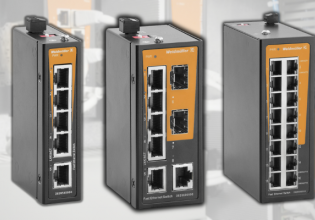WirelessHART Gateway from Endress+Hauser
Endress+Hauser introduces the WSG250 WirelessHART gateway, capable of connecting up to 100 HART devices onto a single network.
Recently, Endress+Hauser introduced the FieldGate SWG50 WirelessHART gateway capable of connecting up to 100 HART devices to common SCADA and other control systems. A gateway for wireless networks, the SWG50 enables HART field devices to communicate and manage network security and connectivity. Equipped with Ethernet interfaces for connecting to host applications, including SCADA tools, the SWG50 also conveniently converts and stores data from field devices in formats compatible with common systems.

Capable of connecting up to 100 HART field devices, the SWG50 is compact and suited for tight spaces. Image used courtesy of Endress+Hauser
HART Communication at its Heart
In process automation, HART is a common protocol to transmit data on top of the analog signal from analog sensors, and digital signals over analog. WirelessHART is a wireless protocol that is becoming very popular for remote process automation applications and is the standard protocol used extensively by Endress+Hauser for its temperature, flow, and pressure sensors.
HART Wireless Network Benefits
A wireless HART network is similar to an ethernet network except that engineers rely on computers to connect and network devices instead of computers being connected. Combining these devices onto a single network reduces the need for extensive programming in SCADA or other control systems.
There are many benefits to wireless communications, but there remain many issues with the technology. The benefits of wireless devices allow for many applications. For example, grain silos often deploy temperature or level sensors located at the top of the silo powered by solar panels. Running cables for the signals back to a SCADA system might be difficult, to say the least. Those signals can be received and processed with a wireless gateway without additional cabling.
One major problem with wireless technology is providing adequate signal strength. Walls blocking the line of sight can degrade signal strength. If the signal drops below a certain threshold, there could be signal loss. Wireless signal security is another issue. Once a network is transmitted wirelessly, malicious devices could join that network, and because WirelessHART allows devices to talk to each other, change parameters in other devices. Regardless, it is important to choose wireless gateways that employ substantial security measures and ensure there are fail-safes in the event of a network attack.

Wireless HART networks are popular because they reduce wiring, networking costs and can connect to flowmeters and many other devices. Image used courtesy of Adobe Stock
Ready for Duty in Tight Spots
Compact and suited for tight spots, the SWG50 has four ethernet ports for connecting to Modbus TCP or HART-IP networks and can be mounted on a standard DIN rail. The SWG50 is also equipped with an external antenna to improve wireless connectivity with remote devices. Configured and monitored via the embedded web server, configurations can be saved to a local PC. With its IP20 rating, the SWG50 gateway is capable of operating in -40°C to +70°C ambient temperatures.






